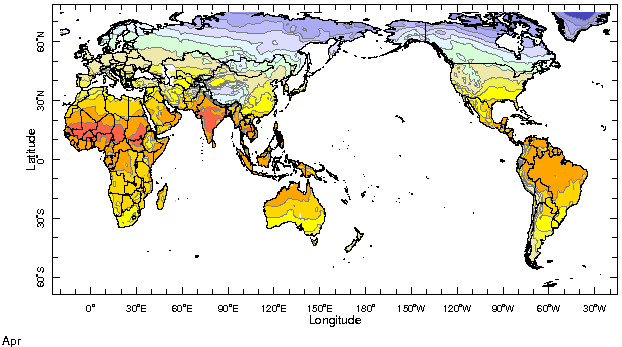|
IRI Climate Digest
May 2004
April Global Climate Summary
Climatological Background
In April, the sun's migration into the northern hemisphere has begun, bringing springtime to the northern mid-latitudes. The monsoon systems which still linger south of the equator will move northward following the solar heating of the continents in the next two months. In the southern hemisphere, fall has arrived, with cooler temperatures and a strengthening of the mid-latitude storm tracks.
Monthly Mean Temperature (1961-1990), data from the Climate Research
Unit, University of East Anglia


Monthly Mean Precipitation (1961-1990), data from the Climate Research
Unit, University of East Anglia


Temperatures
Highlights
Above-average air temperatures characterized most of the tropics in April, including West and southern Africa, the northern Indian subcontinent and southeast Asia, and South America. In the two latter regions, i.e. the Southern Hemisphere monsoon regions of southeast Asia and South America, the above-average temperatures are consistent with below-average precipitation (see "Precipitation Highlights"). The April circulation over north-western Eurasia bore the signs of a predominantly positive North Atlantic Oscillation. Relatively warm air over Scandinavia and cool air over western Russia are consistent with the large-scale circulation over the eastern North Atlantic, Scandinavia and Russia. With this circulation, warm air is advected from the North Atlantic while cold air is advected from the Arctic Ocean. Similarly, the large-scale circulation over the North Pacific, Alaska and northwestern Canada is consistent with warm-air advection and above-average temperatures all along the west coast of Canada and the USA, and cold-air advection and below-average temperatures over eastern Canada and the northeastern USA.
Temperature Difference from the 1961-1990 mean, with data
from NCEP Climate Prediction Center, CAMS.


Precipitation
Highlights
Above-average precipitation persisted in the western equatorial Pacific Ocean, between 150°E and the dateline, while to the west, over the maritime continent, the end of the rainy season was anomalously dry. To the east of the dateline, all across the Pacific and into equatorial South America, abnormally dry conditions also prevailed. The latter half of the rainy season in the semi-arid Brazilian Nordeste was also characterized by below-average precipitation. Portions of East Africa, Eastern Europe, South Asia, south-central Russia, and southern South America all experienced above-average precipitation during April.
Precipitation Difference from 1979-1995 mean, with data
from NCEP Climate Prediction Center, CAMS-OPI.


Oceanic Conditions
Tropical Pacific: Above-average SSTs persisted in the western equatorial Pacific and eastern equatorial Indian Oceans, while in the eastern equatorial Pacific slightly below-average temperatures reached further west, to 120°W. Subsurface temperature anomalies at the equator along the climatological position of the 20°C isotherm are already showing signs of the demise of the cold eastern Pacific anomalies, and an above-normal probability for overall neutral or warm ENSO conditions is forecast for the remainder of the year. See the latest IRI ENSO Update for a detailed summary and outlook.
Atlantic Ocean: Warm tropical and high latitudes of the North Atlantic and cold temperatures off the eastern seaboard of North America drew a picture consistent with a predominantly negative phase of the North Atlantic Oscillation which occurred earlier in the year, in January and February. Cooler-than-normal waters persisted off the coast of southern Africa during April while those east of South America continued to warm.
Indian Ocean: Above-average temperatures remained across much of the Indian Ocean and increased in magnitude south of Madagascar and near the Maritime Continent.
Pacific Mid-latitudes: Few changes were seen in the South Pacific during April as the cool waters surrounding New Zealand and the warm waters in the South-Central Pacific persisted. Sea surface temperatures west of southern South America, however, decreased to below-normal levels. Patches of above-normal temperatures continued in the midlatitudes of the Northern Hemisphere.
Monthly Sea Surface Temperature Difference from the 1971-2000 mean,
with data from the Environmental Modeling Center, NCEP/NOAA.


Contents |
Special |
Impacts |
Climate |
Forecast
|

